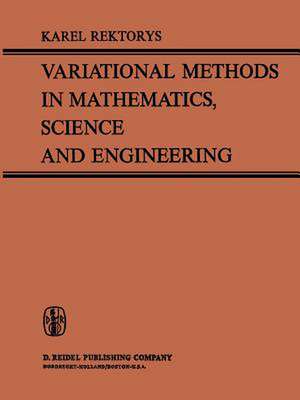Variational Methods in Mathematics, Science and Engineering
Autor Karel Rektorysen Limba Engleză Paperback – 22 ian 2012
Preț: 424.71 lei
Nou
Puncte Express: 637
Preț estimativ în valută:
81.28€ • 84.34$ • 67.93£
81.28€ • 84.34$ • 67.93£
Carte tipărită la comandă
Livrare economică 15-29 martie
Preluare comenzi: 021 569.72.76
Specificații
ISBN-13: 9789401164528
ISBN-10: 9401164525
Pagini: 576
Ilustrații: 571 p.
Dimensiuni: 210 x 280 x 30 mm
Greutate: 1.28 kg
Ediția:Softcover reprint of the original 1st ed. 1977
Editura: SPRINGER NETHERLANDS
Colecția Springer
Locul publicării:Dordrecht, Netherlands
ISBN-10: 9401164525
Pagini: 576
Ilustrații: 571 p.
Dimensiuni: 210 x 280 x 30 mm
Greutate: 1.28 kg
Ediția:Softcover reprint of the original 1st ed. 1977
Editura: SPRINGER NETHERLANDS
Colecția Springer
Locul publicării:Dordrecht, Netherlands
Public țintă
ResearchCuprins
Preface.- Notation Frequently Used.- 1. Introduction.- I. Hilbert Space.- 2. Inner Product of Functions. Norm, Metric.- 3. The Space L2.- 4. Convergence in the Space L2(G) (Convergence in the Mean). Complete Space. Separable Space.- 5. Orthogonal Systems in L2(G).- 6. Hilbert Space.- 7. Some Remarks to the Preceding Chapters. Normed Space, Banach Space.- 8. Operators and Functionals, especially in Hilbert Spaces.- II. Variational Methods.- 9. Theorem on the Minimum of a Quadratic Functional and its Consequences.- 10. The Space HA.- 11. Existence of the Minimum of the Functional F in the Space HA. Generalized Solutions.- 12. The Method of Orthonormal Series. Example.- 13. The Ritz Method.- 14. The Galerkin Method.- 15. The Least Squares Method. The Courant Method.- 16. The Method of Steepest Descent. Example.- 17. Summary of Chapters 9 to 16.- III. Application of Variational Methods to the Solution of Boundary Value Problems in Ordinary and Partial Differential Equations.- 18. The Friedrichs Inequality. The Poincaré Inequality.- 19. Boundary Value Problems in Ordinary Differential Equations.- 20. Problem of the Choice of a Base.- 21. Numerical Examples: Ordinary Differential Equations.- 22. Boundary Value Problems in Second Order Partial Differential Equations.- 23. The Biharmonic Operator. (Equations of Plates and Wall-beams.).- 24. Operators of the Mathematical Theory of Elasticity.- 25. The Choice of a Base for Boundary Value Problems in Partial Differential Equations.- 26. Numerical Examples: Partial Differential Equations.- 27. Summary of Chapters 18 to 26.- IV. Theory of Boundary Value Problems in Differential Equations Based on the Concept of a Weak Solution and on the Lax-Milgram Theorem.- 28. The Lebesgue Integral. Domains with the Lipschitz Boundary.- 29. TheSpace W2(k)(G).- 30. Traces of Functions from the Space W2(k)(G). The Space W?2(k)(G). The Generalized Friedrichs and Poincaré Inequalities.- 31. Elliptic Differential Operators of Order 2k. Weak Solutions of Elliptic Equations.- 32. The Formulation of Boundary Value Problems.- 33. Existence of the Weak Solution of a Boundary Value Problem. V-ellipticity. The Lax-Milgram Theorem.- 34. Application of Direct Variational Methods to the Construction of an Approximation of the Weak Solution.- 35. The Neumann Problem for Equations of Order 2k (the Case when the Form ((v, u)) is not V-elliptic).- 36. Summary and Some Comments to Chapters 28 to 35.- V. The Eigenvalue Problem.- 37. Introduction.- 38. Completely Continuous Operators.- 39. The Eigenvalue Problem for Differential Operators.- 40. The Ritz Method in the Eigenvalue Problem.- 41. Numerical Examples.- VI. Some Special Methods. Regularity of the Weak solution.- 42. The Finite Element Method.- 43. The Method of Least Squares on the Boundary for the Biharmonic Equation (for the Problem of Wall-beams). The Trefftz Method of the Solution of the Dirichlet Problem for the Laplace Equation.- 44. The Method of Orthogonal Projections.- 45. Application of the Ritz Method to the Solution of Parabolic Boundary Value Problems.- 46. Regularity of the Weak Solution, Fulfilment of the Given Equation and of the Boundary Conditions in the Classical Sense. Existence of the Function w ? W2(k)(G) satisfying the Given Boundary Conditions.- 47. Concluding Remarks, Perspectives of the Presented Theory.- Table for the Construction of Most Current Functionals and of Systems of Ritz Equations.- References.








